Cytotoxic Effects of Phytomediated Silver and Gold Nanoparticles Synthesised from Rooibos (Aspalathus linearis), and Aspalathin
Abstract
:1. Introduction
2. Results
2.1. Chemistry of Aspalathin
2.2. UV–Vis Spectrophotometry Analysis
2.3. High-Resolution Transmission Electron Microscope Analysis
2.4. Zeta Potential and Particle Size Distributions of Gold and Silver NPs
2.5. X-ray Diffraction (XRD) Analysis
2.6. Attenuated Total Reflection Fourier-Transform Infrared
2.7. In Vitro Stability Study
2.8. Cell Viability with Biosynthesised AgNPs and AuNPs Using GR and ASP
2.9. Cellular Uptake of AgNPs and AuNPs from GR and ASP
3. Discussion
Proposed Mechanism of the Metal Nanoparticles Formation
4. Materials and Methods
4.1. General
4.2. Cell Culture and Cell Conditioning
4.3. Experimental
4.3.1. Preparation of Plant Extract and Isolation of Aspalathin
4.3.2. Biogenic Synthesis of Gold and Silver Nanoparticles
4.3.3. Characterisation of Nanoparticles
4.3.4. Stability Study
4.3.5. Cell Viability
4.3.6. In Vitro Cellular Uptake of Au and Ag Nanoparticles
4.3.7. Statistical Analyses
5. Conclusions
Supplementary Materials
Author Contributions
Funding
Institutional Review Board Statement
Informed Consent Statement
Data Availability Statement
Acknowledgments
Conflicts of Interest
References
- Zhao, J.; Gou, S.; Liu, F.; Sun, Y.; Gao, C. Anticancer Potency of Platinum (II) Complexes Containing Both Chloride Anion and Chelated Carboxylate as Leaving Groups. Inorg. Chem. 2013, 52, 8163–8170. [Google Scholar] [CrossRef]
- Zhang, J.; Jiang, M.; Li, S.; Zhang, Z.; Sun, H.; Yang, F.; Liang, H. Developing a Novel Anticancer Gold (III) Agent to Integrate Chemotherapy and Immunotherapy. J. Med. Chem. 2021, 64, 6777–6791. [Google Scholar] [CrossRef] [PubMed]
- Mohd Sofyan, N.R.F.; Nordin, F.J.; Mohd Abd Razak, M.R.; Abdul Halim, S.N.A.; Mohd Khir, N.A.F.; Muhammad, A.; Rajab, N.F.; Sarip, R. New silver complexes with mixed thiazolidine and phosphine ligands as highly potent antimalarial and anticancer agents. J. Chem. 2018, 2018, 1–10. [Google Scholar] [CrossRef]
- Ruiz, M.E.; Gantner, M.E.; Talevi, A. Applications of Nanosystems to Anticancer Drug Therapy (Part II. Dendrimers, Micelles, Lipid-based Nanosystems. Recent Pat Anti-Cancer 2014, 9, 99–128. [Google Scholar] [CrossRef]
- Al-radadi, N.S. Green synthesis of platinum nanoparticles using Saudi’s Dates extract and their usage on the cancer cell treatment. Arab. J. Chem. 2019, 12, 330–349. [Google Scholar] [CrossRef]
- Jeyaraj, M.; Gurunathan, S.; Qasim, M.; Kang, M.; Kim, J. A Comprehensive Review on the Synthesis, Characterization, and Biomedical Application of Platinum Nanoparticles. Nanomaterials 2019, 9, 1719. [Google Scholar] [CrossRef] [Green Version]
- Patra, S.; Mukherjee, S.; Barui, A.K.; Ganguly, A.; Sreedhar, B.; Patra, C.R. Green synthesis, characterization of gold and silver nanoparticles and their potential application for cancer therapeutics. Mater. Sci. Eng. C 2015, 53, 298–309. [Google Scholar] [CrossRef] [PubMed]
- Peralta-Videa, J.R.; Huang, Y.; Parsons, J.G.; Zhao, L.; Lopez-Moreno, L.; Hernandez-Viezcas, J.A.; Gardea-Torresdey, J.L. Plant-based green synthesis of metallic nanoparticles: Scientific curiosity or a realistic alternative to chemical synthesis? Nanotechnol. Environ. Eng. 2016, 1, 1–29. [Google Scholar] [CrossRef]
- Oyagi, M.O.; Michira, I.N.; Guto, P.; Baker, P.G.L.; Kamau, G. Polydisperse Low Diameter ‘Non-toxic’ Silver Nanoparticles Encapsulated by Rooibos Tea Templates. Nano Hybrids 2014, 8, 57–72. [Google Scholar] [CrossRef]
- Diallo, A.; Mothudi, B.M.; Manikandan, E.; Maaza, M. Luminescent Eu2O3 nanocrystals by Aspalathus linearis’ extract: Structural and optical properties. J. Nanophotonics 2016, 10, 026010. [Google Scholar] [CrossRef]
- Krafczyk, N.; Glomb, M.A. Characterization of phenolic compounds in rooibos tea. J. Agric. Food Chem. 2008, 56, 3368–3376. [Google Scholar] [CrossRef] [PubMed]
- Stander, M.A.; Van Wyk, B.E.; Taylor, M.J.C.; Long, H.S. Analysis of Phenolic Compounds in Rooibos Tea (Aspalathus linearis) with a Comparison of Flavonoid-Based Compounds in Natural Populations of Plants from Different Regions. J. Agric. Food Chem. 2017, 65, 10270–10281. [Google Scholar] [CrossRef]
- Koeppen, B.H.; Roux, D. Aspalathin: A novel C-glycosylfavonoid from Aspalathus linearis. Tetrahedron Lett. 1965, 6, 3497–3503. [Google Scholar] [CrossRef]
- Marnewick, J.L.; Van Der Westhuizen, F.H.; Joubert, E.; Swanevelder, S.; Swart, P.; Gelderblom, W.C.A. Chemoprotective properties of rooibos (Aspalathus linearis), honeybush (Cyclopia intermedia) herbal and green and black (Camellia sinensis) teas against cancer promotion induced by fumonisin B1 in rat liver. Food Chem. Toxicol. 2009, 47, 220–229. [Google Scholar] [CrossRef]
- Lee, E.-J.; Jang, H.-D. Antioxidant activity and protective effect on DNA strand scission of Rooibos tea (Aspalathus linearis). BioFactors 2004, 21, 285–292. [Google Scholar] [CrossRef]
- Komatsu, K.; Kator, K.; Mitsuda, Y.; Mine, M.; Okumura, Y. Inhibitory effects of Rooibos tea, Aspalathus linearis, on X-ray-induced C3H 10T 1/2 cell transformation. Cancer Lett. 1994, 77, 33–38. [Google Scholar] [CrossRef]
- Omolaja, A.A.; Brendon, P.; Omoruyia, S.I.; Badmus, J.A.; Ismail, E.; Marnewick, J.L.; Botha, S.; Benjeddou, M.; Ekpob, O.E.; Hussein, A.A. The potential of chalcone-capped gold nanoparticles for the management of diabetes mellitus. Surfaces Interfaces 2021, 2, 101251. [Google Scholar] [CrossRef]
- Badeggi, U.M.; Ismail, E.; Adeloye, A.O.; Botha, S.; Hussein, A.A. Green Synthesis of Gold Nanoparticles Capped with Procyanidins from Leucosidea sericea as Potential Antidiabetic and Antioxidant Agents. Biomolecules 2020, 10, 452. [Google Scholar] [CrossRef] [PubMed] [Green Version]
- Badeggi, U.M.; Badmus, J.A.; Botha, S.; Ismail, E.; Marnewick, J.L.; Charlene, W.J.A.; Hussein, A.A. Biosynthesis, Characterization, and Biological Activities of Procyanidin Capped Silver Nanoparticles. J. Funct. Biomater. 2020, 11, 66. [Google Scholar] [CrossRef]
- Akinfenwa, A.O.; Abdul, S.N.; Marnewick, J.L.; Hussein, A.A. Protective Effects of Linearthin and Other Chalcone Derivatives from Aspalathus linearis (Rooibos) Against UVB Induced Oxidative Stress and Toxicity in Human Skin Cells. Plants 2021, 10, 1936. [Google Scholar] [CrossRef] [PubMed]
- Adewale, B.O.; Hajierah, D.; Lynn, C.; Saartjie, R. Toxicological Behavior of Gold Nanoparticles on Various Models: Influence of Physicochemical Properties and Other Factors. Int. J. Toxicol. 2019, 38, 357–384. [Google Scholar] [CrossRef] [PubMed]
- Phuoc Van, T.; Shinnosuke, A.; Kenichiro, K.; Nobuo, S.; Kazumasa, T.; Toru, S.; Takashi, K. Size/shape control of gold nanoparticles synthesized by alternating current glow discharge over liquid: The role of pH. Mater. Res. Express 2019, 6, 095074. [Google Scholar]
- Analike, B.S.; Daniela, K.; Giorgia, C.; Mauro, P.; Maribanyana, L.; Nonhlanhla, C.; Suprakas, S.R.; Namrita, L. Synthesis and characterisation of gold nanoparticles biosynthesised from Aspalathus linearis (Burm.f.) R. Dahlgren For progressive macular hypomelanosis. J. Herb. Med. 2021, 2, 100481. [Google Scholar]
- Smith, C.; Swart, A. Aspalathus linearis (Rooibos)–a functional food targeting cardiovascular disease. R. Soc. Chem. Food Funct. 2018, 9, 5041–5058. [Google Scholar] [CrossRef]
- Ali, Z.A.; Yahya, R.; Sekaran, S.D.; Puteh, R. Green synthesis of silver nanoparticles using apple extract and its antibacterial properties. Adv. Mater. Sci. Eng. 2016, 1–6. [Google Scholar] [CrossRef] [Green Version]
- Danaei, M.; Dehghankhold, M.; Ataei, S.; Hasanzadeh, D.F.; Javanmard, R.; Dokhani, A.; Khorasani, S.; Mozafari, M.R. Impact of Particle Size and Polydispersity Index on the Clinical Applications of Lipidic Nanocarrier Systems. Pharmaceutics 2018, 10, 57. [Google Scholar] [CrossRef] [PubMed] [Green Version]
- Nune, S.K.; Chanda, N.; Shukla, R.; Katti, K.; Kulkami, R.R.; Thilakayathy, S.; Mekapothula, S.; Katti, K.V. Green nanotechnology from tea: Phytochemicals in tea as building blocks for production of biocompatible gold nanoparticles. J. Mater. Chem. 2019, 19, 2912–2920. [Google Scholar] [CrossRef] [PubMed] [Green Version]
- Dykman, L.A.; Khlebtsov, N.G. Uptake of Engineered Gold Nanoparticles into Mammalian Cell. Chem. Rev. 2014, 114, 1258–1288. [Google Scholar] [CrossRef]
- Malugin, A.; Ghandehari, H. Cellular uptake and toxicity of gold nanoparticles in prostate cancer cells: A comparative study of rods and spheres. J. Appl. Toxicol. 2010, 30, 212–217. [Google Scholar]
- Heinrich, T.; Willenberg, I.; Glomb, M.A. Chemistry of colour formation during rooibos fermentation. J. Agric. Food Chem. 2012, 60, 5221–5228. [Google Scholar] [CrossRef]
- Nakamura, Y.; Watanabe, S.; Miyake, N.; Kohno, H.; Osawa, T. Dihydrochalcones: Evaluation as novel radical scavenging antioxidants. J. Agric. Food Chem. 2003, 51, 3309–3312. [Google Scholar] [CrossRef] [PubMed]
- Rezk, B.M.; Haenen, G.R.; van der Vijgh, W.J.; Bast, A. The antioxidant activity of phloretin: The disclosure of a new antioxidant pharmacophore in flavonoids. Biochem. Biophys. Res.Commun. 2002, 295, 9–13. [Google Scholar] [CrossRef]
- Honary, S.; Zahir, F. Effect of zeta potential on the properties of nano-drug delivery systems—A review (Part 1). Trop. J. Pharm. Res. 2013, 12, 255–264. [Google Scholar]
- De Beer, D.; Joubert, E.; Manley, M. Enhancing aspalathin stability in rooibos (Aspalathus linearis) ready-to-drink iced teas during storage: The role of nano-emulsification and beverage ingredients, citric and ascorbic acids. J. Sci. Food Agric. 2012, 92, 274–282. [Google Scholar] [CrossRef]
- Krafczyk, N.; Heinrich, T.; Porzel, A.; Glomb, M. Oxidation of the dihydrochalcone Aspalathin leads to dimerization. J. Agric. Food Chem. 2009, 2, 6838–6843. [Google Scholar] [CrossRef] [PubMed]
- Barbosa, L.R.S.; Ortore, M.G.; Spinozzi, F.; Mariani, P.; Bernstorff, S. The Importance of Protein-Protein Interactions on the pH-Induced Conformational Changes of Bovine Serum Albumin: A Small-Angle X-ray Scattering Study. Biophys. J. 2010, 98, 147–157. [Google Scholar] [CrossRef]
- Marnewick, J.; Joubert, E.; Joseph, S.; Swanevelder, S.; Swart, P.; Gelderblom, W. Inhibition of tumour promotion in mouse skin by extracts of rooibos (Aspalathus linearis) and honeybush (Cyclopia intermedia), unique South African herbal teas. Cancer Lett. 2005, 224, 193–202. [Google Scholar] [CrossRef]
- Marnewick, J.; Gelderblom, W.; Joubert, E. An investigation on the antimutagenic properties of South African herbal teas. Mutat. Res. 2000, 471, 157–166. [Google Scholar] [CrossRef]
- Pantsi, W.G.; Marnewick, J.L.; Esterhuyse, A.J.; Rautenbach, F.J.; Van Rooyen, J. Rooibos (Aspalathus linearis) offers cardiac protection against ischaemia/reperfusion in the isolated perfused rat heart. Phytomedicine 2011, 18, 1220–1228. [Google Scholar] [CrossRef] [PubMed]
- Huang, S.-H.; Tseng, J.-C.; Lin, C.-Y.; Kuo, Y.-Y.; Wang, B.-J.; Kao, Y.-H.; Muller, C.J.; Joubert, E.; Chuu, C.-P. Rooibos suppresses proliferation of castration-resistant prostate cancer cells via inhibition of Akt signaling. Phytomedicine 2019, 64, 153068. [Google Scholar] [CrossRef]
- Piao, M.J.; Kang, K.A.; Lee, I.K.; Kim, H.S.; Kim, S.; Choi, J.Y.; Choi, J.; Hyun, J.W. Silver nanoparticles induce oxidative cell damage in human liver cells through inhibition of reduced glutathione and induction of mitochondria-involved apoptosis. Toxicol. Lett. 2011, 201, 92–100. [Google Scholar] [CrossRef]
- Behzadi, S.; Serpooshan, V.; Tao, W.; Hamaly, M.A.; Alkawareek, M.Y.; Dreaden, E.C.; Brown, D.; Alkilany, A.M.; Farokhzad, O.C.; Mahmoudi, M. Cellular Uptake of Nanoparticles: Journey Inside the Cell. Chem. Soc. Rev. 2017, 46, 4218–4244. [Google Scholar] [CrossRef]
- Foroozandeh, P.; Aziz, A.A. Insight into Cellular Uptake and Intracellular Trafficking of Nanoparticles. Nanoscale Res. Lett. 2018, 13, 339. [Google Scholar] [CrossRef]
- Meiyu, W.; Hongbo, G.; Lin, L.; Ying, L.; Liming, X. Size-dependent cellular uptake and localization profiles of silver nanoparticles. Int. J. Nanomed. 2019, 14, 4247–4259. [Google Scholar]
- Alkilany, A.M.; Murphy, C.J. Toxicity and cellular uptake of gold nanoparticles: What we have learned so far? J. Nanopart. Res. 2010, 12, 2313–2333. [Google Scholar] [CrossRef] [Green Version]
- Amina, S.J.; Biu, G. A Review on the Synthesis and Functionalization of Gold Nanoparticles as a Drug Delivery Vehicle. Int. J. Nanomed. 2020, 15, 9823–9857. [Google Scholar] [CrossRef] [PubMed]
- Barbara, D.; Dimitri, V.; Laura, R.-L.; Alke, P.-F. Barbara Rothen-Rutishauser. Quantifying nanoparticle cellular uptake: Which method is best? Nanomedicine 2017, 12, 1095–1099. [Google Scholar]
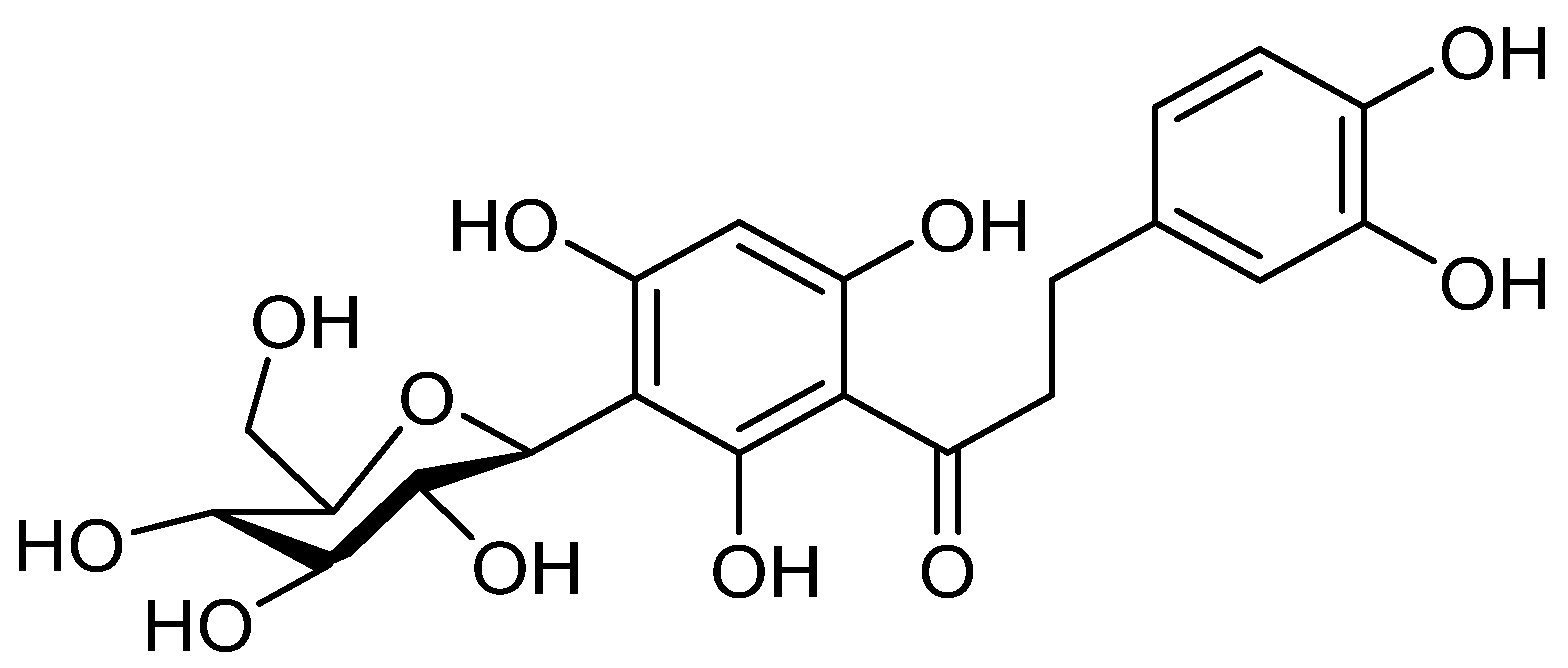

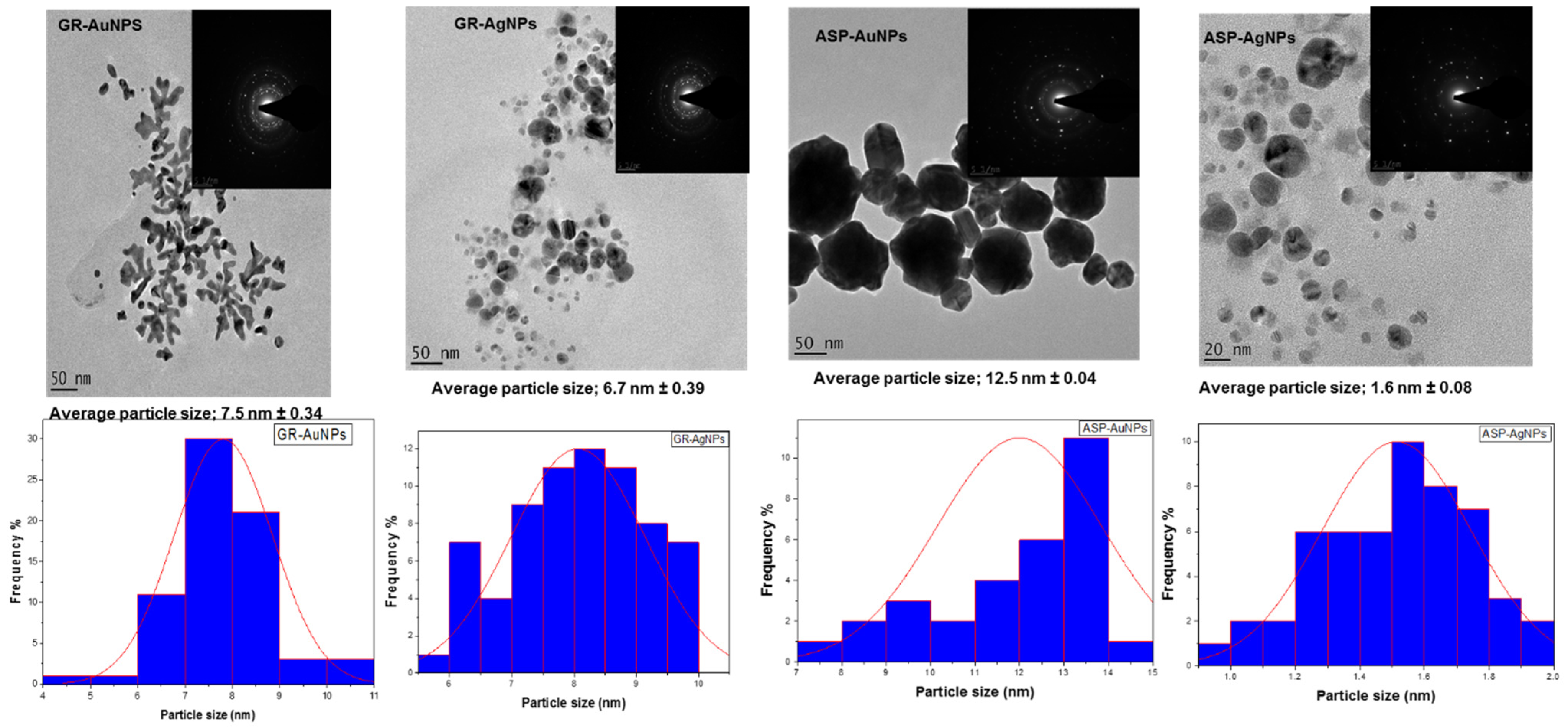





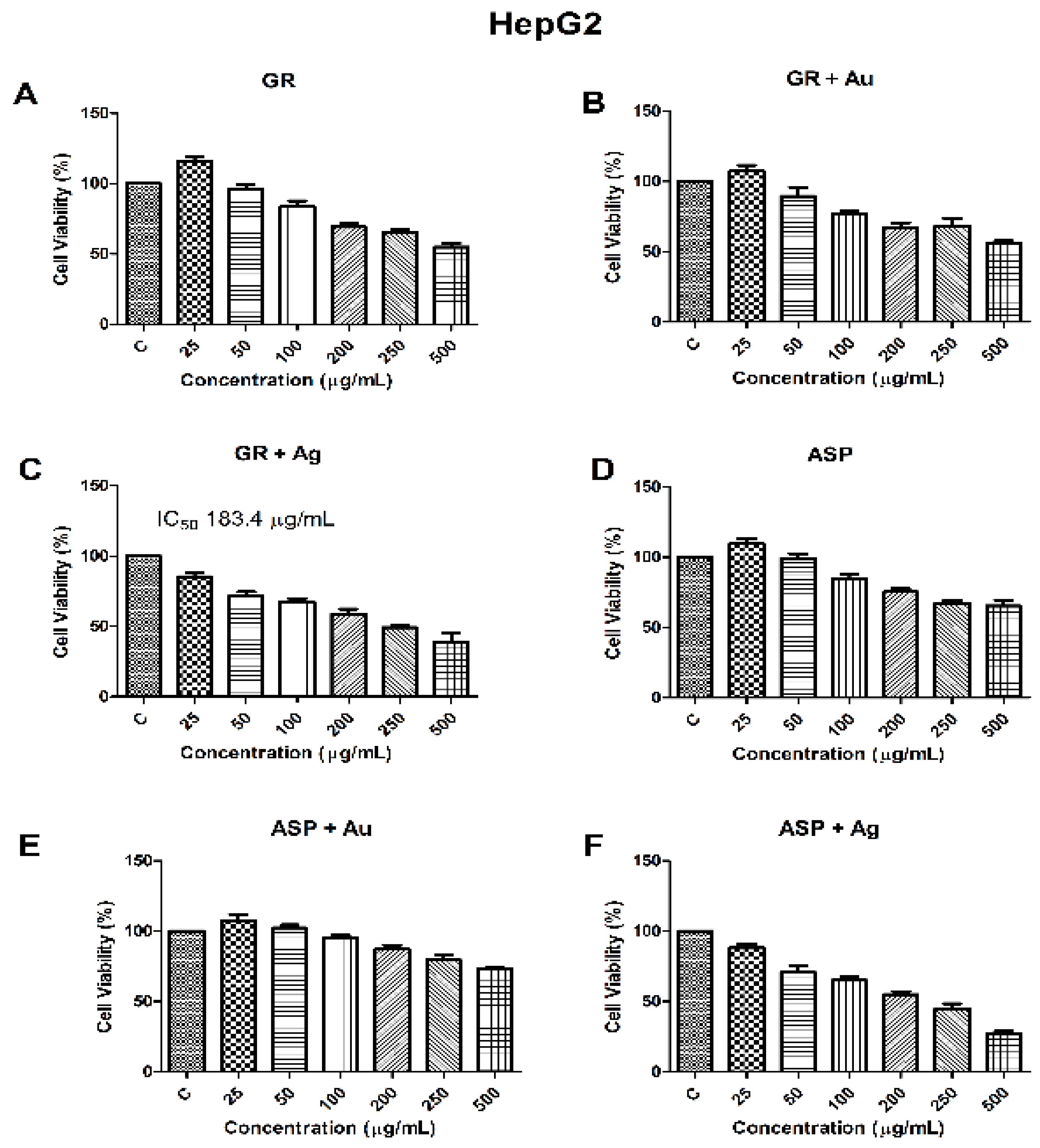
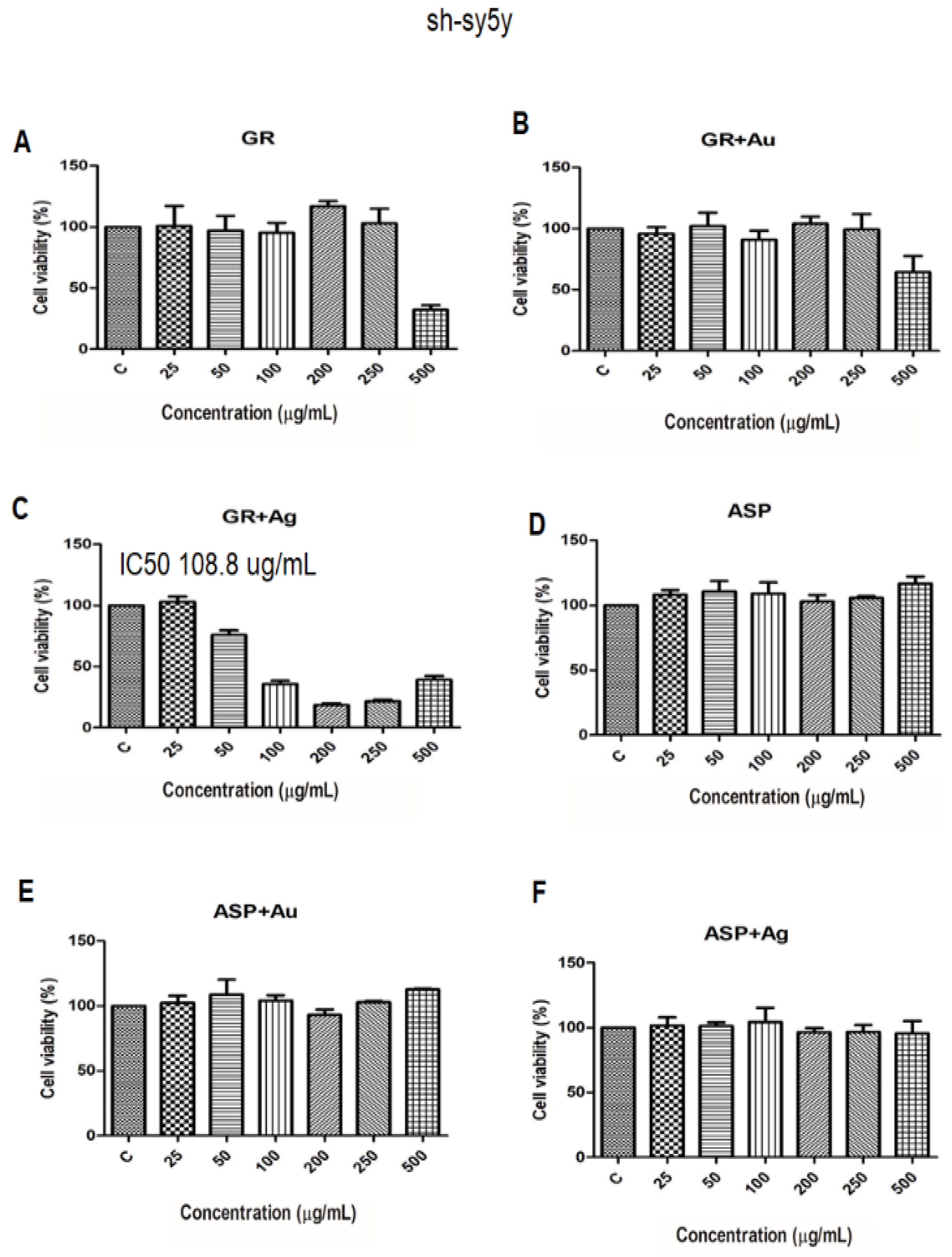

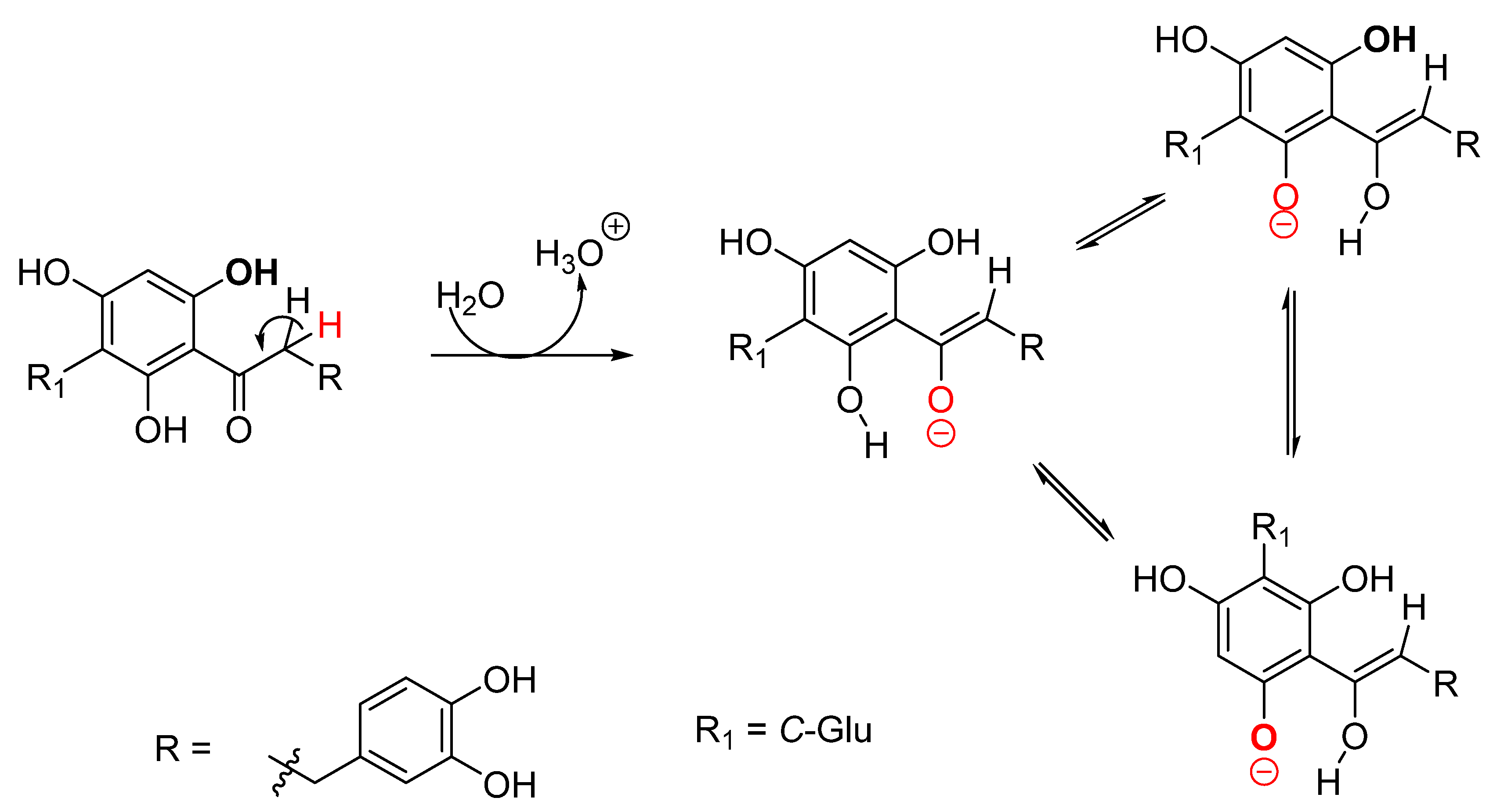
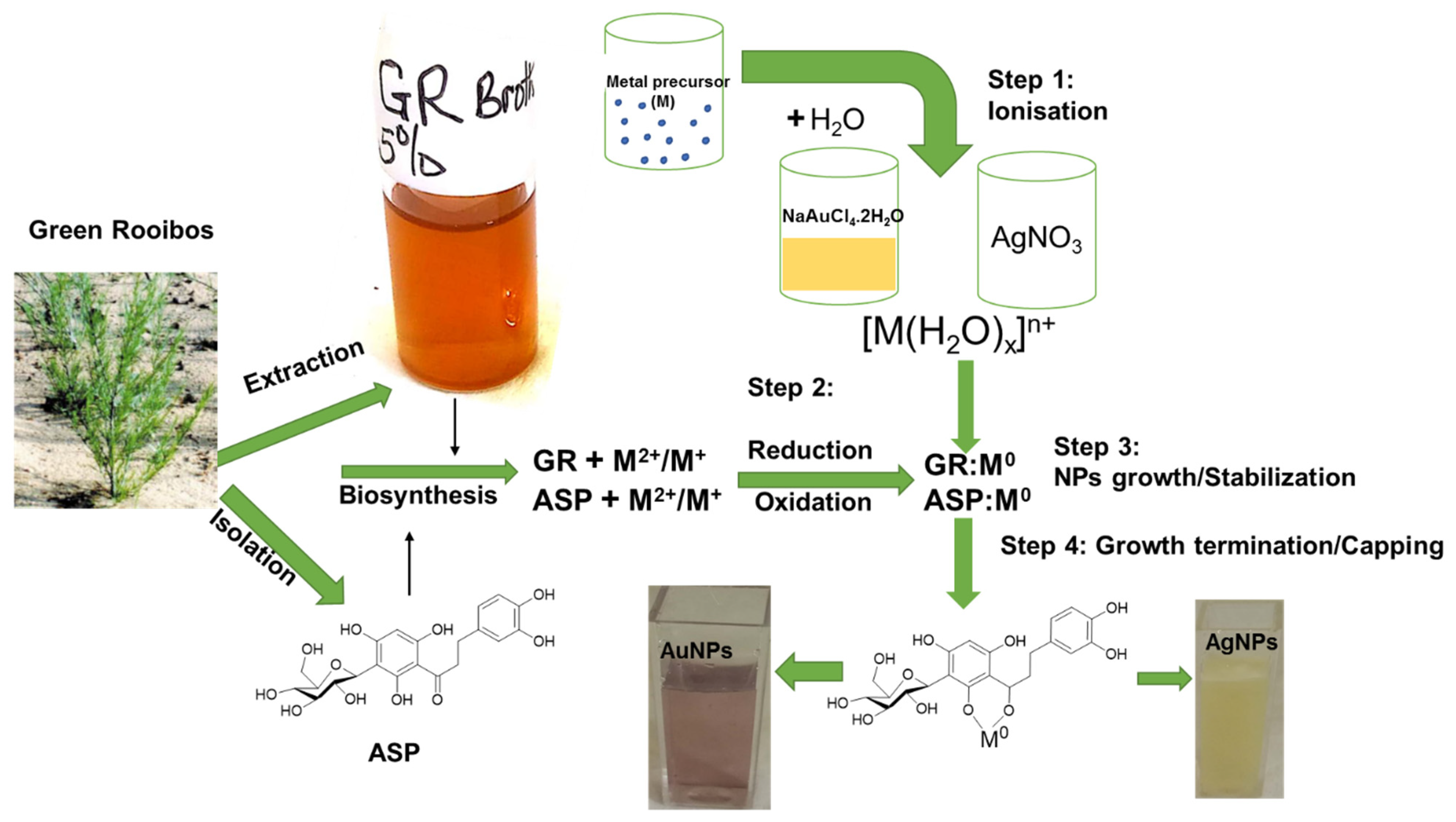
| Samples | Hydrodynamic Sizes (nm) | Zeta Potential (mV) | PDI |
|---|---|---|---|
| GR-AuNPs | 107.0 | −26.2 | 0.128 |
| GR-AgNPs | 109.0 | −15.0 | 0.274 |
| ASP-AgNPs | 136.4 | −26.7 | 0.100 |
| ASP-AuNPs | 104.7 | −19.2 | 0.111 |
Publisher’s Note: MDPI stays neutral with regard to jurisdictional claims in published maps and institutional affiliations. |
© 2021 by the authors. Licensee MDPI, Basel, Switzerland. This article is an open access article distributed under the terms and conditions of the Creative Commons Attribution (CC BY) license (https://creativecommons.org/licenses/by/4.0/).
Share and Cite
Akinfenwa, A.O.; Abdul, N.S.; Docrat, F.T.; Marnewick, J.L.; Luckay, R.C.; Hussein, A.A. Cytotoxic Effects of Phytomediated Silver and Gold Nanoparticles Synthesised from Rooibos (Aspalathus linearis), and Aspalathin. Plants 2021, 10, 2460. https://doi.org/10.3390/plants10112460
Akinfenwa AO, Abdul NS, Docrat FT, Marnewick JL, Luckay RC, Hussein AA. Cytotoxic Effects of Phytomediated Silver and Gold Nanoparticles Synthesised from Rooibos (Aspalathus linearis), and Aspalathin. Plants. 2021; 10(11):2460. https://doi.org/10.3390/plants10112460
Chicago/Turabian StyleAkinfenwa, Akeem O., Naeem S. Abdul, Fathima T. Docrat, Jeanine L. Marnewick, Robbie C. Luckay, and Ahmed A. Hussein. 2021. "Cytotoxic Effects of Phytomediated Silver and Gold Nanoparticles Synthesised from Rooibos (Aspalathus linearis), and Aspalathin" Plants 10, no. 11: 2460. https://doi.org/10.3390/plants10112460
APA StyleAkinfenwa, A. O., Abdul, N. S., Docrat, F. T., Marnewick, J. L., Luckay, R. C., & Hussein, A. A. (2021). Cytotoxic Effects of Phytomediated Silver and Gold Nanoparticles Synthesised from Rooibos (Aspalathus linearis), and Aspalathin. Plants, 10(11), 2460. https://doi.org/10.3390/plants10112460







